Saddle stitch binding (stapled) — most economical with shortest delivery time
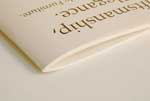
Saddle stitching is the least expensive binding method. Pages need to be in increments of 4. The range of total number of pages is 8 to 96 pages. This method of binding allows for the shortest delivery time.
Perfect binding — flat spine, 48 pages minimum
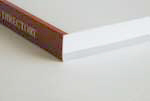
Perfect binding is the next step up in the cost of binding. Pages can be in single page increments. Minimum number of pages is 48 providing there is at least 1/8 inch body thickness. There is some versatility in the use of various papers in a single book. Because of the square binding edge, spine copy can be used as a distinctive touch.
Hard bound binding most durable. Advanced planning is essential
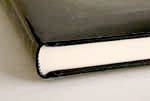
Case or hard cover binding usually has the pages sewn together similar to the way that books have been bound for the last 600 years. This binding method is very durable. The pages should be printed in signatures (sections) of 16-pages with a minimum thickness of 1/4 inch for best effect.
In Europe many books are sewn with a paper cover instead of a hard cover.
Advance planning is essential for this type of binding giving consideration to the type of paper used, end papers, paper grain direction, cover material, thickness of cover boards, etc.
Mechanical binding uses metal or plastic spiraled spines
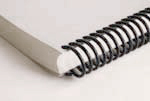
This type of binding allows for binding of single sheets, usually a minimum of 32 pages (16 sheets). This method of binding is best for short run books, and when it is desirable for the final product to lay flat. It also has the advantage of combining different types of paper stock.
Types of material for the actual binding are plastic combs, plastic or metal spiral or a double wire.
Loose-leaf binding (3-ring binder) for easy updates
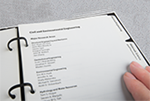
This method of binding commonly uses a 3-ring binder. Paper to be inserted is drilled with 1/4 or 5/16 inch holes. Multiple projects can be placed in the binder. This is the only binding method that allows for insertion of updated material.
Die cut tab dividers can assist readers through sections of a binder
Tab dividers have an approximate half inch section that extends past the face of a book or multi-page document. The purpose of the divider is to assist the reader to easily find a particular section of the book.
The type of binding that allows the greatest flexibility and lowest relative cost of tab dividers would be loose leaf binding such as ring, Wire-O, or spiral binding. The tabs are inserted by hand at any position desired.
Tabs inserted into a perfect bound book must have the tab portion folded back to allow for the face trimming of the book after the covers and body are glued together. A second consideration when perfect binding a book is the position of the tabs in relationship to the pages or signatures. The gathering or collation of the tabs and book pages is a mechanical process with limited number of collating pockets. To hold costs down, communicate to Castle Press the desired position of the tabs during the design process. Changing the position of the tabs can easily double the collating cost of the book.
Saddle stitched books that have divider tabs require a 4-page signature that wraps around the spine with 2-pages in the front half of the book and the remaining 2-pages in the back half of the book. Tabs in a saddle stitched book allow for no face trim after stitching of the page signatures. Because of this, all pages have to be trimmed to final face or width size before binding.
Additionally, the tab pages require die cutting to create the tab.
Standard sized divider tabs save money
There are two ways to make divider tabs. If the divider page is smaller than 9 x 12 inches and uses a standard radius tab edge, the die cutting process uses either a high die that cuts 200 tabs at a time or a high speed rotary die cutter. Both of these methods of die cutting are low cost.
The expensive way is to design a special shape for the divider tab or to have a final size greater than 9 x 12 inches. The reason for the additional expense is that a special cutting die is made. Then the press sheet of divider tabs must be die cut on a cylinder press operating at about 3,000 sheets per hour.
Wire-O and spiral binding offers flexibility and low-cost tab dividers
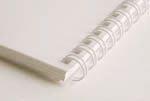
A Wire-O binding holds the covers and pages of a document firmly in place by a double-loop wire inserted through holes drilled in their left edges. All of the document’s pages lie flat when opened. Wire-O books can also be folded back to 360 degrees without damage to the spine.
Wire-o books allow for images or charts spread across two pages, and are ideal for any book that needs to stay open when not being held: cookbooks, instruction manuals, calendars, or meeting materials. Wire-O books are durable, but do not permit printing on the document spine or the insertion of new pages.
Wire-O bindings come in nine standard colors and loop diameters from 3/16" to 1-1/4". They can handle documents from 1/8" to 1" thick.
See also:
Click Here to Print from your Uploaded PDF
Click Here to Print from your Design Created Online